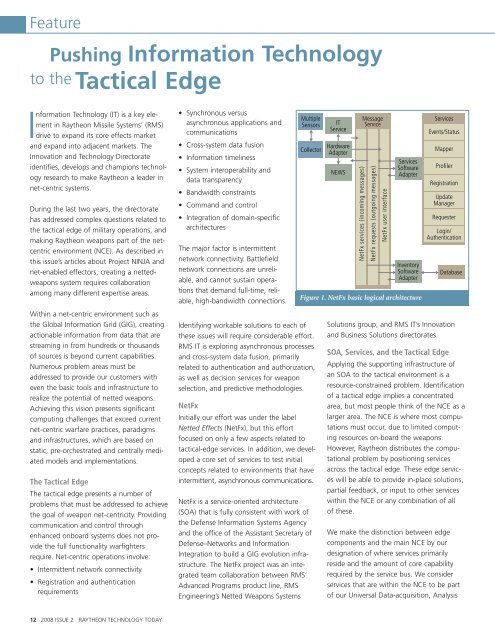2008 Issue 2 - Raytheon
2008 Issue 2 - Raytheon
2008 Issue 2 - Raytheon
Create successful ePaper yourself
Turn your PDF publications into a flip-book with our unique Google optimized e-Paper software.
Feature<br />
Pushing Information Technology<br />
to the Tactical Edge<br />
Information Technology (IT) is a key element<br />
in <strong>Raytheon</strong> Missile Systems’ (RMS)<br />
drive to expand its core effects market<br />
and expand into adjacent markets. The<br />
Innovation and Technology Directorate<br />
identifies, develops and champions technology<br />
research to make <strong>Raytheon</strong> a leader in<br />
net-centric systems.<br />
During the last two years, the directorate<br />
has addressed complex questions related to<br />
the tactical edge of military operations, and<br />
making <strong>Raytheon</strong> weapons part of the netcentric<br />
environment (NCE). As described in<br />
this issue’s articles about Project NINJA and<br />
net-enabled effectors, creating a nettedweapons<br />
system requires collaboration<br />
among many different expertise areas.<br />
Within a net-centric environment such as<br />
the Global Information Grid (GIG), creating<br />
actionable information from data that are<br />
streaming in from hundreds or thousands<br />
of sources is beyond current capabilities.<br />
Numerous problem areas must be<br />
addressed to provide our customers with<br />
even the basic tools and infrastructure to<br />
realize the potential of netted weapons.<br />
Achieving this vision presents significant<br />
computing challenges that exceed current<br />
net-centric warfare practices, paradigms<br />
and infrastructures, which are based on<br />
static, pre-orchestrated and centrally mediated<br />
models and implementations.<br />
The Tactical Edge<br />
The tactical edge presents a number of<br />
problems that must be addressed to achieve<br />
the goal of weapon net-centricity. Providing<br />
communication and control through<br />
enhanced onboard systems does not provide<br />
the full functionality warfighters<br />
require. Net-centric operations involve:<br />
Intermittent network connectivity<br />
Registration and authentication<br />
requirements<br />
12 <strong>2008</strong> ISSUE 2 RAYTHEON TECHNOLOGY TODAY<br />
Synchronous versus<br />
asynchronous applications and<br />
communications<br />
Cross-system data fusion<br />
Information timeliness<br />
System interoperability and<br />
data transparency<br />
Bandwidth constraints<br />
Command and control<br />
Integration of domain-specific<br />
architectures<br />
The major factor is intermittent<br />
network connectivity. Battlefield<br />
network connections are unreliable,<br />
and cannot sustain operations<br />
that demand full-time, reliable,<br />
high-bandwidth connections.<br />
Multiple<br />
Sensors<br />
Collector<br />
Identifying workable solutions to each of<br />
these issues will require considerable effort.<br />
RMS IT is exploring asynchronous processes<br />
and cross-system data fusion, primarily<br />
related to authentication and authorization,<br />
as well as decision services for weapon<br />
selection, and predictive methodologies.<br />
NetFx<br />
Initially our effort was under the label<br />
Netted Effects (NetFx), but this effort<br />
focused on only a few aspects related to<br />
tactical-edge services. In addition, we developed<br />
a core set of services to test initial<br />
concepts related to environments that have<br />
intermittent, asynchronous communications.<br />
NetFx is a service-oriented architecture<br />
(SOA) that is fully consistent with work of<br />
the Defense Information Systems Agency<br />
and the office of the Assistant Secretary of<br />
Defense–Networks and Information<br />
Integration to build a GIG evolution infrastructure.<br />
The NetFx project was an integrated<br />
team collaboration between RMS’<br />
Advanced Programs product line, RMS<br />
Engineering’s Netted Weapons Systems<br />
IT<br />
Service<br />
Hardware<br />
Adapter<br />
NEWS<br />
Message<br />
NetFx services (incoming messages)<br />
NetFx requests (outgoing messages)<br />
NetFx user interface<br />
Service<br />
Services<br />
Software<br />
Adapter<br />
Inventory<br />
Software<br />
Adapter<br />
Figure 1. NetFx basic logical architecture<br />
Services<br />
Events/Status<br />
Mapper<br />
Profiler<br />
Registration<br />
Update<br />
Manager<br />
Requester<br />
Login/<br />
Authentication<br />
Database<br />
Solutions group, and RMS IT’s Innovation<br />
and Business Solutions directorates.<br />
SOA, Services, and the Tactical Edge<br />
Applying the supporting infrastructure of<br />
an SOA to the tactical environment is a<br />
resource-constrained problem. Identification<br />
of a tactical edge implies a concentrated<br />
area, but most people think of the NCE as a<br />
larger area. The NCE is where most computations<br />
must occur, due to limited computing<br />
resources on-board the weapons.<br />
However, <strong>Raytheon</strong> distributes the computational<br />
problem by positioning services<br />
across the tactical edge. These edge services<br />
will be able to provide in-place solutions,<br />
partial feedback, or input to other services<br />
within the NCE or any combination of all<br />
of these.<br />
We make the distinction between edge<br />
components and the main NCE by our<br />
designation of where services primarily<br />
reside and the amount of core capability<br />
required by the service bus. We consider<br />
services that are within the NCE to be part<br />
of our Universal Data-acquisition, Analysis
















